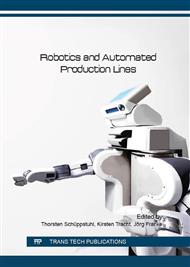p.50
p.58
p.66
p.74
p.82
p.91
p.99
p.107
p.114
Application of Customizable Robot Assistance Systems to Compensate Age-Related Restrictions of the Musculoskeletal System for Assembly Workplaces
Abstract:
Due to the demographic change, hybrid work systems increasingly gain importance. Especially, robot based assistance systems show potential to respond individually to employee’s performance parameters. Existing technologies offer possibilities to capture individual performance parameters which can be transferred into a digital environment. Identified impairments, e.g. of the musculoskeletal system, can be used to design an individual work environment with human-robot collaboration that fits the employee’s needs to guarantee a low risk of physical harm due to work related strain. Following the employee’s capabilities, the simulation reveals stressful activities that can be transferred to the robot. Thus, the work system offers the opportunity to individually respond to the employee and the given tasks by creating a work situation that suits the employee’s preconditions. This paper presents an approach for capturing individual physical performance parameters in form of movement restrictions by a motion capturing system without markers and the transmission of the motion data into a digital human model. It will be shown how the simulation can be used to design a needs-based work place by integration of a robot based assistance system.
Info:
Periodical:
Pages:
82-90
Citation:
Online since:
June 2016
Authors:
Price:
Сopyright:
© 2016 Trans Tech Publications Ltd. All Rights Reserved
Share:
Citation:


